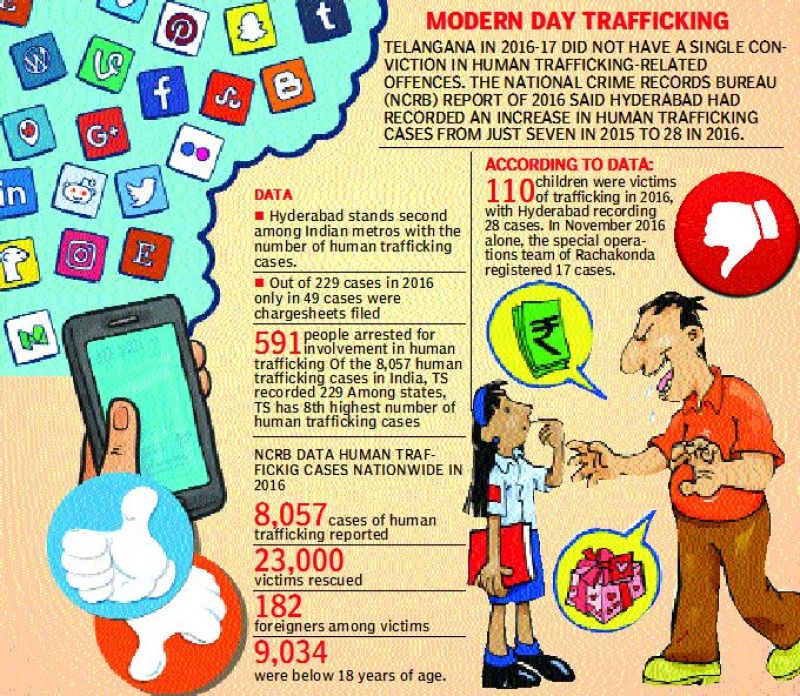Social media fails to crack trafficking

Hyderabad: Human trafficking is the second largest organised crime after drugs. It is estimated that the revenue generated out of trafficking worldwide is $150 billion. Yet very little is being done to curb it in a systematic way and young girls and women are its biggest victims. What happened to 13-year-old Padma (name changed) is typical of how the trade operates. She was made to drop out of Gandhi Chowk-Khammam Government School as her elder sister Sushma decided that she must work to support the family.
Sushma struck a deal with a broker Neeraj who promised a job as a domestic maid in Hyderabad’s Jubilee Hills with a monthly salary of Rs 10,000. Instead Padma was put on board the Hyderabad- Maharashtra Express together with other minors and taken to a brothel in Chandrapur, and from there to Pune’s red light area. The girls were confined to a room with a guard at the door. Fortunately, a Mumbai based NGO, Rescue Foundation, and the Pune police, acting on a tip-off raided the brothel and found the girls concealed in a bunker below the beds. The girls were taken to a rescue home in Mumbai and the Telangana police were informed about Padma.
Rachakonda Police Commissioner Mahesh Bhagwat who oversaw the operation said, “When we reached Bhiwandi-Mumbai area, we found 29 girls from Telangana rescued by the Foundation from various brothels. They informed me of Padma. She was quick to share her family and district details. When we checked with Khammam police authorities, no missing case was found since the family weren’t aware. The team brought back Padma and the 28 rescued girls. The only way to trace trafficked women and children is through early intervention. Technology may help in spreading facial recognition of the trafficked victims, but it will not help us get to them.”
Children and women who go missing are kidnapped and sent to brothels and inducted into begging, child pornography, used as camel jockeys and forced labour. The key remains early rescue either by the police or families of the missing children and women.

IPS officer Mahesh Bhagwat, who has been listed in the 100 Human Trafficking and Slavery Influence Leaders, said, “All missing cases are not trafficked, part of the 10-15 per cent are kidnapped for beggary, forced labour in unorganised sectors like factories, certain kids trafficked to other countries for domestic help, prostitution. The only mechanism of repatriating them is through immediate intervention. In case of delay in rescue, the victims get used to the unorganised crime. Even if they are rescued they refuse to return home fearing that society will not accept them.”
Shalini Pandey, volunteer at a city-based anti-trafficking NGO, Hyderabad for Children, said, “When a missing case if filed, the police and family may use social platforms to spread the word. But history has proven that those trapped in the flesh trade are only traced through rescue operations. Many don’t connect with the facial recognition of those missing or victims’ photos being circulated. Many times children forget their original names.”
“There are organised gangs that operate in certain districts like Kadri town in Anantapur trafficking girls to Mumbai and Delhi. In coastal Andhra Pradesh, gangs were arrested in West-East Godavari. In Telangana most cases are found in Adilabad-Maharashtra border, trafficked from Nalgonda, Yadadri, Warangal, and Hyderabad,” says Anil Reddy, a volunteer with a Hyderabad for Children NGO.
Recently, a signature campaign was launched by a member of the Rajya Sabha and a report submitted to the upper-house by Rajeev Chandrasekar, a member of the Rajya Sabha. The report said that ‘11 children go missing every hour. 3-4-month-old babies are being kidnapped and trafficked and raised by brothel owners so that they can be pushed into prostitution as soon as they get a bit older. Girls as young as 10 are given hormone injections to look older for the ‘customers’. “Girls and boys as young as six years are filmed performing sexual acts and those videos are then sold on the internet,” it said.

